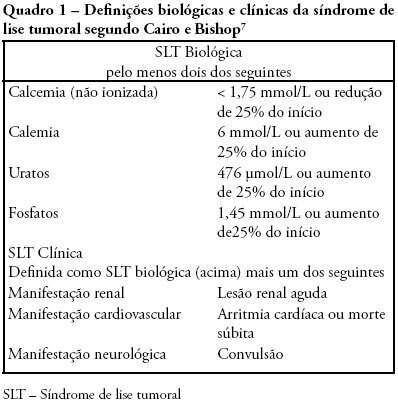Abstract
Rev Bras Ter Intensiva. 2008;20(3):278-285
DOI 10.1590/S0103-507X2008000300011
Tumor lysis syndrome is characterized by the massive destruction of malignant cells and the release in the extra-cellular space of their content. While Tumor lysis syndrome may occur spontaneously before treatment, it usually develops shortly after the initiation of cytotoxic chemotherapy. These metabolites can overwhelm the homeostatic mechanisms with development of hyperuricaemia, hyperkalaemia, hyperphosphataemia, and hypocalcaemia. These biological manifestations may lead to clinical manifestations including, acute kidney injury, seizure, or sudden death that require intensive care. Since clinical tumor lysis syndrome is associated with a poor prognosis both prevention of tumor lysis syndrome and prevention of clinical consequences of tumor lysis syndrome are mandatory. The objective of this review is to describe pathophysiological mechanisms, biological and clinical manifestations of tumor Lysis syndrome, and to provide upto-date guidelines to ensure prevention of tumor lysis syndrome. Review of selected studies on tumor lysis syndrome published at the PubMed database www.pubmed.gov during the last 20 years. Additional references were retrieved from the studies initially selected. Tumor lysis syndrome is a frequent and life-threatening complication of the newly diagnosed malignancies. Preventive measures, including hydration, uricolytic agents, eviction of factors predisposing to acute kidney injury and, in the more severe patients, on prophylactic renal replacement therapy, are required to prevent or limit clinical consequences of Tumor lysis syndrome. However optimal timing and modalities of prevention remains unknown and may be modified by the changing spectrum of patients at risk of tumor lysis syndrome. Development and validation of risk based strategies is required to limit the high morbidity and mortality of this complication.

Abstract
Rev Bras Ter Intensiva. 2006;18(1):18-21
DOI 10.1590/S0103-507X2006000100004
BACKGROUND AND OBJECTIVES: The aim of this study was to analyze the morbidity and the mortality of critically ill patients admitted to the intensive care unit in a teaching hospital, using the APACHE II score. METHODS: Descriptive and retrospective study, with analysis of 300 patients admitted to ICU from March 2004 to July 2005. RESULTS: Of the 300 patients admitted to ICU, 51.7% were men, average 54.2 ± 19.57 years and 78% from the wards of the teaching hospital itself. There was more prevalence of patients aged 60 years or older (43%). The main dysfunctions were from the respiratory and cardiocirculatory systems. Length of stay in ICU was 7.51 ± 8.21 days. The mean of APACHE II was 16.48 ± 7.67, with meaningful difference between survivors and deceased patients. The real mortality rate in ICU was 32.7%, without meaningful difference between patients that died before or after 48 hours. The standardized mortality ratio was 1.1. CONCLUSIONS: Despite the severity of the patients admitted to ICU, the standardized mortality ratio suggests a satisfactory quality in the service.

Abstract
Rev Bras Ter Intensiva. 2006;18(1):27-33
DOI 10.1590/S0103-507X2006000100006
BACKGROUND AND OBJECTIVES: Nosocomial infection represents a challenge in clinical practice involving hospitalized patients, as they considerably extend the hospitalization period and morbidity and mortality rates and, at the same time, increase hospital costs. Given their clinical conditions, which require invasive procedures and antimicrobial treatment, hospitalized patients, especially at the Intensive Care Unit, are particularly susceptible to hospital infection. This study aimed to evaluate the occurrence of multiresistant bacteria in patients hospitalized at the Intensive Care Unit of a Brazilian emergency hospital. METHODS: Our retrospective study was approved by the Ethics Committee and considered the period between October 2003 and September 2004. A database was developed through variable coding and double entry, and Statistical Package for Social Sciences (SPSS) software, version 10.0, was used for statistical analysis. RESULTS: Multiresistant bacteria were identified in 68 patients, 47 (69.1%) of whom were men, with 55 years as the mean age. All patients were submitted to endotracheal intubation and central venipuncture. The most frequent bacteria were coagulase-negative Staphylococcus sp. (36.4%), followed by Staphylococcus aureus (19%). Cephalosporin was the most frequently used (21.4%) antimicrobial agent. CONCLUSIONS: Knowledge on infection occurrence provokes reflections on multiresistance, directs educative actions and favors interventions to prevent and control problem situations.
